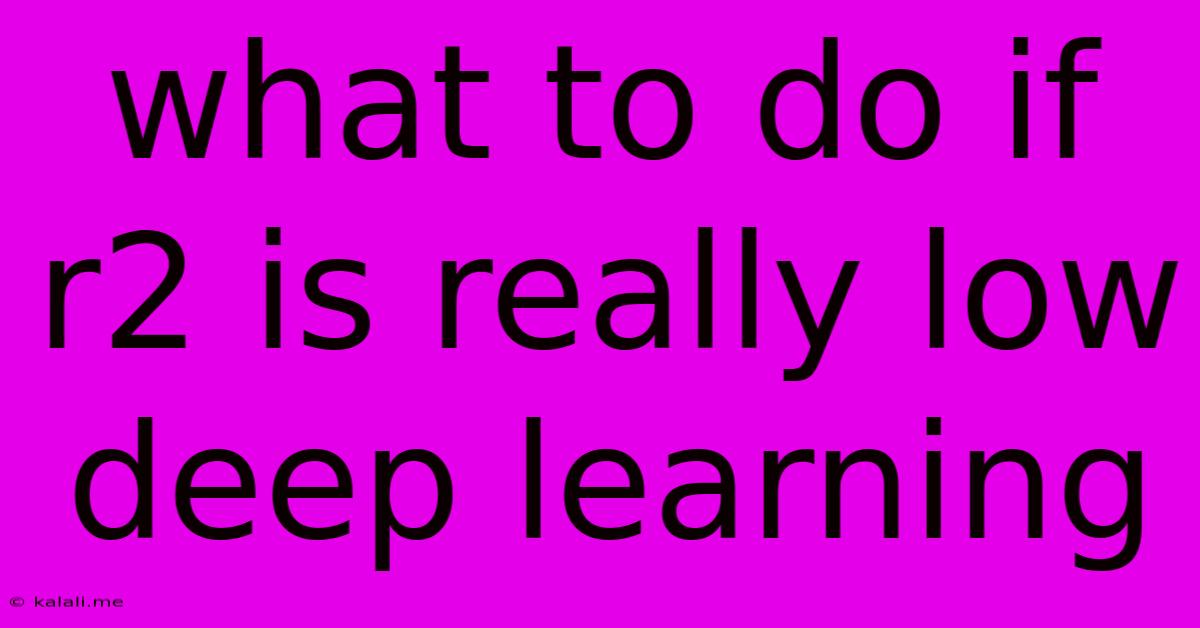What To Do If R2 Is Really Low Deep Learning
Kalali
May 30, 2025 · 4 min read

Table of Contents
What to Do if Your R-squared (R²) is Really Low in Deep Learning
Getting a low R-squared (R²) value in your deep learning model is frustrating, but it's a common problem with a variety of potential solutions. A low R² indicates your model isn't explaining much of the variance in your data, meaning it's not performing well at predicting your target variable. This article explores the common causes of low R² in deep learning and offers actionable strategies to improve your model's performance.
Understanding R-squared in Deep Learning
Before diving into solutions, let's clarify what R² represents. In regression tasks, R² measures the proportion of the variance in the dependent variable that is predictable from the independent variables. A value of 1.0 indicates a perfect fit, while 0.0 suggests the model explains none of the variance. In deep learning, where models can be highly complex, interpreting R² requires careful consideration. A low R² doesn't automatically mean your model is useless; it simply points to areas for improvement.
Common Causes of Low R² in Deep Learning Models
Several factors can contribute to a low R² score:
- Insufficient Data: Deep learning models thrive on large datasets. Insufficient data can lead to underfitting, where the model is too simple to capture the complexities in your data. More data often improves model performance.
- Poor Feature Engineering: The quality of your input features significantly impacts model performance. Irrelevant, redundant, or poorly scaled features can hinder learning. Feature scaling (standardization or normalization), feature selection, and feature creation are crucial steps.
- Model Complexity: While deep learning models are powerful, an overly complex model (too many layers or neurons) can lead to overfitting. Overfitting means the model memorizes the training data instead of learning generalizable patterns. This results in poor performance on unseen data, even with a seemingly high R² on the training set.
- Inappropriate Model Architecture: The choice of model architecture is critical. A convolutional neural network (CNN) might be suitable for image data, but not necessarily for time series data. Selecting the right architecture based on your data's characteristics is essential.
- Hyperparameter Tuning: Deep learning models have many hyperparameters (learning rate, batch size, number of epochs, etc.) that significantly influence performance. Poorly tuned hyperparameters can lead to suboptimal results.
- Data Preprocessing Issues: Missing values, outliers, and noisy data can all negatively impact your model's ability to learn. Careful data cleaning and preprocessing are vital.
- Underfitting: Your model might be too simple to capture the underlying patterns in your data. This is indicated by consistently low R² values on both training and validation sets.
Strategies to Improve Your R² Score
Here's how to address these issues and potentially boost your R²:
1. Data Augmentation and Collection
- Gather More Data: The simplest solution is often to acquire more data. More data points provide the model with more information to learn from.
- Data Augmentation: If obtaining more data is challenging, consider data augmentation techniques. These create synthetic data by modifying existing data points (e.g., rotating images, adding noise to time series).
2. Feature Engineering
- Feature Scaling: Standardize or normalize your features to ensure they have similar scales. This prevents features with larger values from dominating the learning process.
- Feature Selection: Identify and remove irrelevant or redundant features. Techniques like feature importance from tree-based models or correlation analysis can help.
- Feature Creation: Create new features by combining existing ones or applying transformations (e.g., polynomial features, interaction terms).
3. Model Optimization
- Hyperparameter Tuning: Use techniques like grid search, random search, or Bayesian optimization to find the optimal hyperparameter settings for your model.
- Regularization: Add regularization techniques (L1 or L2) to prevent overfitting. These techniques add penalties to the model's loss function, discouraging overly complex models.
- Dropout: Introduce dropout layers in your neural network to further prevent overfitting. Dropout randomly deactivates neurons during training, forcing the network to learn more robust features.
- Early Stopping: Monitor your model's performance on a validation set and stop training when the validation performance starts to decrease. This prevents overfitting to the training data.
- Different Model Architectures: Explore different model architectures. If a simple model underfits, try a deeper or more complex one; if a complex model overfits, try a simpler architecture.
4. Data Preprocessing
- Handle Missing Values: Impute missing values using appropriate techniques (mean imputation, k-NN imputation).
- Outlier Detection and Treatment: Identify and handle outliers using techniques like capping, winsorization, or removing outliers.
- Data Cleaning: Ensure your data is clean and consistent, addressing any inconsistencies or errors.
Conclusion
A low R² in deep learning isn't necessarily a death sentence. By systematically investigating potential causes and applying the strategies outlined above, you can significantly improve your model's performance and achieve a higher R² score. Remember that iterative experimentation and careful analysis are crucial for building successful deep learning models. The journey to a high R² often involves careful consideration of your data, model architecture, and hyperparameters.
Latest Posts
Latest Posts
-
Can You Replace Just The Tank On A Toilet
May 31, 2025
-
Where Is The Mic On The 3ds
May 31, 2025
-
Doctors First Name Or Doctors First Name
May 31, 2025
-
Effect Of Leading Edge Slat On Lift Curve Slope
May 31, 2025
-
What Did Jesus Say About The Old Testament Law
May 31, 2025
Related Post
Thank you for visiting our website which covers about What To Do If R2 Is Really Low Deep Learning . We hope the information provided has been useful to you. Feel free to contact us if you have any questions or need further assistance. See you next time and don't miss to bookmark.